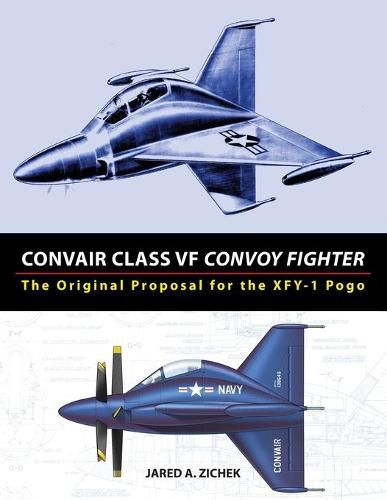Readings Newsletter
Become a Readings Member to make your shopping experience even easier.
Sign in or sign up for free!
You’re not far away from qualifying for FREE standard shipping within Australia
You’ve qualified for FREE standard shipping within Australia
The cart is loading…






This title is printed to order. This book may have been self-published. If so, we cannot guarantee the quality of the content. In the main most books will have gone through the editing process however some may not. We therefore suggest that you be aware of this before ordering this book. If in doubt check either the author or publisher’s details as we are unable to accept any returns unless they are faulty. Please contact us if you have any questions.
This book presents the original proposal for the Convair Class VF Convoy Fighter of 1950, which led to the XFY-1 Pogo turboprop tailsitter naval aircraft. It was one of five submissions to the US Navy’s Convoy Fighter competition, which called for a single-seat high performance fighter designed to protect convoy vessels from attack by enemy aircraft, and for vertical unassisted takeoff from, and landings on, small platform areas afloat or ashore. Every detail of the proposal is covered, including armament variations, landing gear alternatives, and an unbuilt small scale technology demonstrator. While the XFY-1 retained the original configuration of the proposal, nearly every contour was subtly changed during the type’s evolution. As a bonus, a pair of Convair design studies for a vertical takeoff observation and reconnaissance tailsitter aircraft submitted to the US Army in 1955 are also included. Finally, there is the little-known Gamby Vertigo Plane, an early VTOL tailsitter design evaluated by NACA in 1933. This 40 page book features 45 images, including rare photos, detailed blueprints, contemporary illustrations, and beautiful color profiles. This is the fourth in a series of monographs covering the Navy’s Convoy Fighter competition of 1950; previous volumes on the Goodyear, Martin and Northrop designs are still available from booksellers worldwide.
$9.00 standard shipping within Australia
FREE standard shipping within Australia for orders over $100.00
Express & International shipping calculated at checkout
This title is printed to order. This book may have been self-published. If so, we cannot guarantee the quality of the content. In the main most books will have gone through the editing process however some may not. We therefore suggest that you be aware of this before ordering this book. If in doubt check either the author or publisher’s details as we are unable to accept any returns unless they are faulty. Please contact us if you have any questions.
This book presents the original proposal for the Convair Class VF Convoy Fighter of 1950, which led to the XFY-1 Pogo turboprop tailsitter naval aircraft. It was one of five submissions to the US Navy’s Convoy Fighter competition, which called for a single-seat high performance fighter designed to protect convoy vessels from attack by enemy aircraft, and for vertical unassisted takeoff from, and landings on, small platform areas afloat or ashore. Every detail of the proposal is covered, including armament variations, landing gear alternatives, and an unbuilt small scale technology demonstrator. While the XFY-1 retained the original configuration of the proposal, nearly every contour was subtly changed during the type’s evolution. As a bonus, a pair of Convair design studies for a vertical takeoff observation and reconnaissance tailsitter aircraft submitted to the US Army in 1955 are also included. Finally, there is the little-known Gamby Vertigo Plane, an early VTOL tailsitter design evaluated by NACA in 1933. This 40 page book features 45 images, including rare photos, detailed blueprints, contemporary illustrations, and beautiful color profiles. This is the fourth in a series of monographs covering the Navy’s Convoy Fighter competition of 1950; previous volumes on the Goodyear, Martin and Northrop designs are still available from booksellers worldwide.